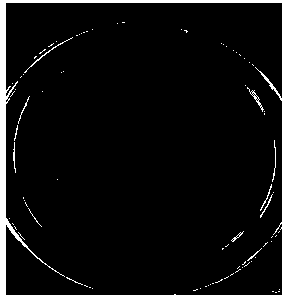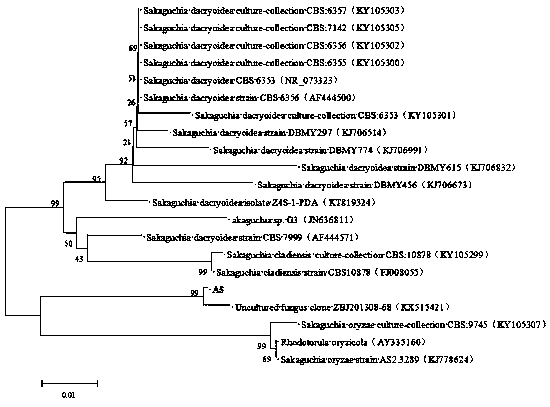Degradation bacteria for sulfonamide antibiotics and application thereof
A technology of sulfonamides and antibiotics, applied in the field of environmental pollutant treatment, can solve problems such as antibiotic pollution, achieve the effects of reducing harm, good degradation effect, and broad application prospects
- Summary
- Abstract
- Description
- Claims
- Application Information
AI Technical Summary
Problems solved by technology
Method used
Image
Examples
Embodiment 1
[0029] Example 1 Isolation and identification of sulfonamide antibiotic-degrading bacteria
[0030] 1. Experimental materials
[0031] Nutrient medium: 5 g sodium chloride, 3 g beef extract, 10 g protein, 1000 mL distilled water, pH 7.0-7.2. For solid medium, add agar powder (bar) 15 g / L. Inorganic salt medium: (NH 4 ) 2 SO 4 1g, MgSO 4 ·7H 2 O 0.1g, KH 2 PO 4 3g,K 2 HPO 4 ·3H 2 O 7g, sodium citrate 0.5g, distilled water 1000mL, pH 7.0-7.2.
[0032] Before the experiment, the medium was placed in a high-pressure steam sterilizer, and sterilized at 121° C. for 30 minutes.
[0033] 2. Isolation and identification of strains
[0034] (1) Screening and domestication of sulfa antibiotic-resistant bacteria:
[0035] Microbial domestication proceeds in four stages. To collect contaminated soil samples from a livestock and poultry farm in the Pearl River Delta, first add the soil samples to 100 mL of nutrient medium containing sulfonamide antibiotics (10 mg / L) under a...
Embodiment 2
[0046] The mensuration of the growth curve of embodiment 2 yeast A5
[0047] 1. Inoculate yeast A5 into LB medium and LB medium containing sulfonamide antibiotics respectively, place them on a shaker at 25 °C and 150 r / min at constant temperature, and culture them at 0.5, 1, 1.5, 2, 3, 4, 6, 8, 10, 12, 24, 36, 48, 60, 72, 96, 120, 144, 168, 192, 216 h sampling, determination of culture medium OD 600 , zeroed with sterilized LB liquid medium.
[0048] The LB medium is: NaCl 5g / L, yeast extract 10g / L, trypsin 10g / L, water 1000mL, pH 7.0-7.2.
[0049] The LB medium containing sulfa antibiotics is as follows: adding sulfamethazine to the above LB medium to make the concentration 100 mg / L.
[0050] 2. The result is as follows Figure 4 As shown, the yeast A5 can also grow normally in the culture system containing sulfa antibiotics.
Embodiment 3
[0051] Example 3 Saccharomyces Degradation Experiment of Saccharomyces A5
[0052] 1. Experimental method
[0053] (1) Preparation of bacterial suspension:
[0054] Scrape 1~2 loops of bacteria A5 from the seed preservation slope, insert them into sterilized LB medium, wrap them up and place them in a constant temperature shaker incubator (25°C, 150 r / min), and expand the culture for 24~36 h. Take the culture solution of activated bacteria A5, centrifuge (6000 r / min, 25°C), collect the bacteria, wash twice with sterile water (6000 r / min, 25°C), and then resuspend with sterile water to prepare A certain concentration of bacterial suspension.
[0055] (2) Degradation of Sulfamethazine by Saccharomyces A5:
[0056] A certain amount of sulfamethazine was added to the high-pressure sterilized inorganic salt medium as the sole carbon source to make the concentration 1 mg / L; then 1 mL of bacterial suspension was added to make the bacterial dosage 1 g / L (wet weight); at the same ...
PUM
 Login to View More
Login to View More Abstract
Description
Claims
Application Information
 Login to View More
Login to View More - R&D
- Intellectual Property
- Life Sciences
- Materials
- Tech Scout
- Unparalleled Data Quality
- Higher Quality Content
- 60% Fewer Hallucinations
Browse by: Latest US Patents, China's latest patents, Technical Efficacy Thesaurus, Application Domain, Technology Topic, Popular Technical Reports.
© 2025 PatSnap. All rights reserved.Legal|Privacy policy|Modern Slavery Act Transparency Statement|Sitemap|About US| Contact US: help@patsnap.com



